Unit 4 Don't eat in class. section A Gramma Focus课件(19张PPT)
文档属性
| 名称 | Unit 4 Don't eat in class. section A Gramma Focus课件(19张PPT) | 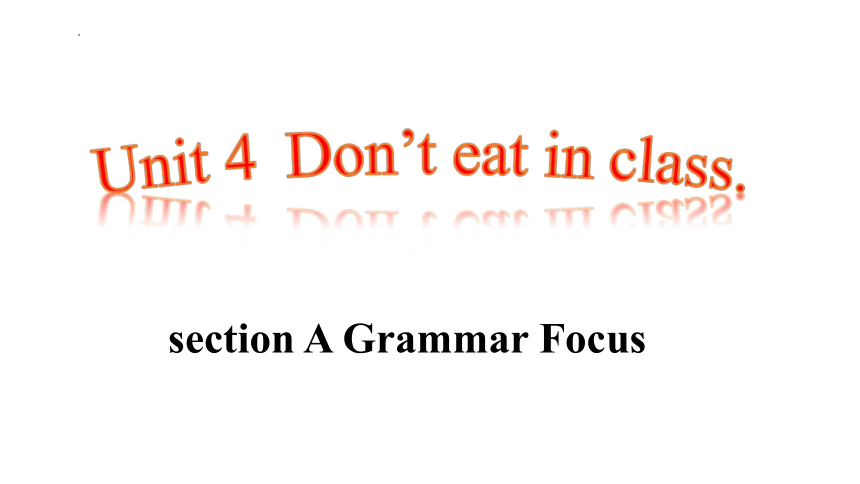 | |
| 格式 | pptx | ||
| 文件大小 | 336.3KB | ||
| 资源类型 | 教案 | ||
| 版本资源 | 人教新目标(Go for it)版 | ||
| 科目 | 英语 | ||
| 更新时间 | 2022-04-12 15:01:41 | ||
图片预览

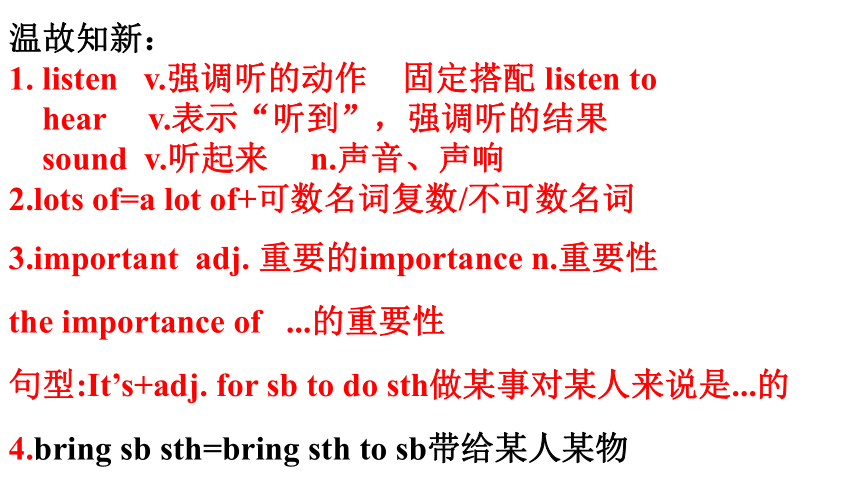

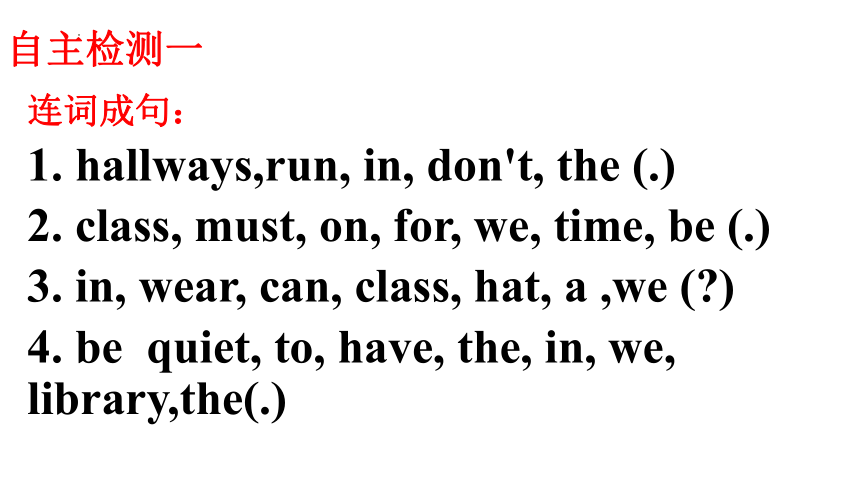
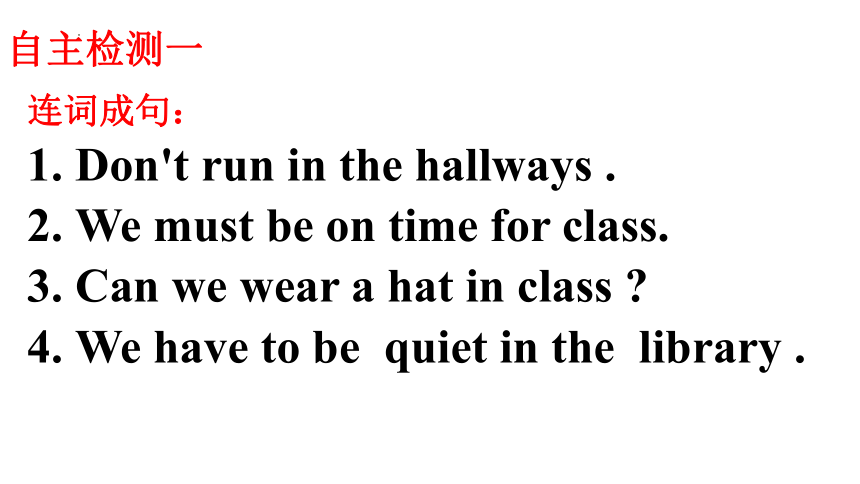

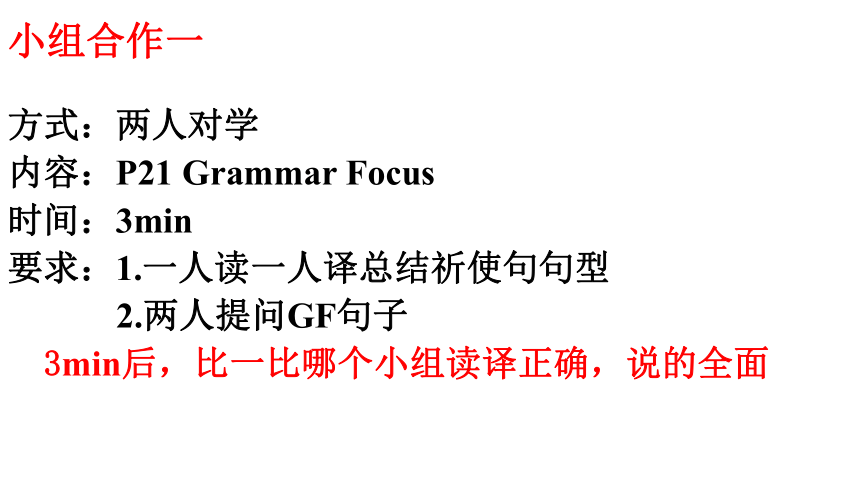
文档简介
(共19张PPT)
Unit 4 Don’t eat in class.
section A Grammar Focus
温故知新:
1. listen v.强调听的动作 固定搭配 listen to
hear v.表示“听到”,强调听的结果
sound v.听起来 n.声音、声响
2.lots of=a lot of+可数名词复数/不可数名词
3.important adj. 重要的importance n.重要性
the importance of ...的重要性
句型:It’s+adj. for sb to do sth做某事对某人来说是...的4.bring sb sth=bring sth to sb带给某人某物
自主学习一
方式:个人独学
内容:P21 Grammar Focus
时间:3min
要求:①大声朗读句子并翻译
自主检测一
连词成句:
1. hallways,run, in, don't, the (.)
2. class, must, on, for, we, time, be (.)
3. in, wear, can, class, hat, a ,we ( )
4. be quiet, to, have, the, in, we, library,the(.)
自主检测一
连词成句:
1. Don't run in the hallways .
2. We must be on time for class.
3. Can we wear a hat in class
4. We have to be quiet in the library .
自主学习二
方式:个人独学
内容:P21 3a , 3b
时间:3min
要求:①完成3a
②根据3b例句仿写3个句子
3min后,小组内比一比谁的答案正确、写的准确
小组合作一
方式:两人对学
内容:P21 Grammar Focus
时间:3min
要求:1.一人读一人译总结祈使句句型
2.两人提问GF句子
3min后,比一比哪个小组读译正确,说的全面
我们最流利
我们最棒
小组合作二
方式:两人对学
内容:P21 3a , 3b
时间:5min
要求:①核对答案
②讨论知识点。
3min后,比一比哪个小组答案正确,读的准确
我最积极,我最棒!
Library Rules
Don’t talk.
__________________
__________________
__________________
3a Write the rules for the
school library.
Writing
Don’t listen to music.
Don’t eat or drink.
Don’t take photos.
方法指导:
1. 由图示可知都是一些禁止类的祈使句。
2. 可知应用“Don’t + 动词原形”句子。
Keep quiet!
2. Eat (he/have to/in the dining hall)
Q: ________________________________
A: _____________
3. Listen to music (we/can/in the hallways)
Q: ________________________________
A: _____________
4. Wear a hat (we/can/in the classroom)
Q: _____________________________
A: ____________
3bThen answer the questions.
Yes, he does.
Does he have to eat in the dining hall
Can we listen to music in the hallways
No, we can’t.
Can we wear a hat in the classroom
No, we can’t.
这节课我学到了......
小结:
1).肯定祈使句:
1.V.+其他
2.Be +adj.
3.let sb do
4.please+v.+其他
2).否定祈使句
1.Don't +V原 Don't eat too much .
2.No+V-ing No smoking \ swimming.
3.No+ n. No sports
4.let sb not do /don’t let sb do
3).must: 必须 1.情态动词+V原 无人称变化 主观个人想要这么做 2.must引起的疑问句,肯定回答一般用must,否定回答一般用needn't或don't/doesn't have to,意思是“不必”;must的否定形式mustn't表示禁止,意思是“不能,不许”
4).have to:1.have to +V原 不得不
2. have to有人称、数和时态的变化,其第三人称单数形式为has to.
3.含有 have to,has to的句子需分别借助助动词do,does 构成疑问句或否定句
习题巩固
1. He _____ (have to ) ____ (do)his homework first.
2.- ___ run in the hallways, Mike .-Sorry ,Miss Li.
A. Don't B. Please C. let's
3. My grandpa is old and he needs to be __(安静的)
4. Mr. Black always goes to work ___ time .
He is never late .
A. at B. on C. in D .with
5. Ken ,No ___ here. It's dangerous.
A. swim B. swiming C. swimming
has to
do
A
quiet
B
C
小测 (必做)
1.We must ____ on time .
A. to be B. be C . are D. is
2. You have to ____ in the library .
A. quiet B. quietly C. be quiet D. be quietly
3. ____ sleep late . It's bad for your health .
A. Do B. Not C. Don't D. Please not
4.____ away this dirty shirt , and bring me a clean one.
A. To take B. Bring C. Carry D. Take
选做
-Please don't throw the paper on the ground.
- ____ I won't .
A. Excuse me B. That's all right C. Sorry
D. It's doesn't matter
情
态
动
词
1. Students _______ wear the uniforms at school.
2. We ____ study hard at school.
A. must B. have to
must: 必须 1.情态动词+V原 无人称变化 主观个人想要这么做 2.must引起的疑问句,肯定回答一般用must,否定回答一般用needn't或don't/doesn't have to,意思是“不必”;must的否定形式mustn't表示禁止,意思是“不能,不许”
have to:1.have to +V原 不得不
2. have to有人称、数和时态的变化,其第三人称单数形式为has to.
3.含有 have to,has to的句子需分别借助助动词do,does 构成疑问句或否定句
B
A
祈使句:祈使句概说用于表达命令、请求、劝告、警告、禁止等的句子叫祈使句。
1.No ________ ( talk ) in class.
2. Don't ____ (run) in the room.
talking
run
2).否定祈使句
1.Don't +V原 Don't eat too much .
2.No+V-ing No smoking \ swimming.
3.No+ n. No sports
4.let sb not do /don’t let sb do
1).肯定祈使句:
1.V.+其他
2.Be +adj.
3.let sb do
4.please+v.+其他
Unit 4 Don’t eat in class.
section A Grammar Focus
温故知新:
1. listen v.强调听的动作 固定搭配 listen to
hear v.表示“听到”,强调听的结果
sound v.听起来 n.声音、声响
2.lots of=a lot of+可数名词复数/不可数名词
3.important adj. 重要的importance n.重要性
the importance of ...的重要性
句型:It’s+adj. for sb to do sth做某事对某人来说是...的4.bring sb sth=bring sth to sb带给某人某物
自主学习一
方式:个人独学
内容:P21 Grammar Focus
时间:3min
要求:①大声朗读句子并翻译
自主检测一
连词成句:
1. hallways,run, in, don't, the (.)
2. class, must, on, for, we, time, be (.)
3. in, wear, can, class, hat, a ,we ( )
4. be quiet, to, have, the, in, we, library,the(.)
自主检测一
连词成句:
1. Don't run in the hallways .
2. We must be on time for class.
3. Can we wear a hat in class
4. We have to be quiet in the library .
自主学习二
方式:个人独学
内容:P21 3a , 3b
时间:3min
要求:①完成3a
②根据3b例句仿写3个句子
3min后,小组内比一比谁的答案正确、写的准确
小组合作一
方式:两人对学
内容:P21 Grammar Focus
时间:3min
要求:1.一人读一人译总结祈使句句型
2.两人提问GF句子
3min后,比一比哪个小组读译正确,说的全面
我们最流利
我们最棒
小组合作二
方式:两人对学
内容:P21 3a , 3b
时间:5min
要求:①核对答案
②讨论知识点。
3min后,比一比哪个小组答案正确,读的准确
我最积极,我最棒!
Library Rules
Don’t talk.
__________________
__________________
__________________
3a Write the rules for the
school library.
Writing
Don’t listen to music.
Don’t eat or drink.
Don’t take photos.
方法指导:
1. 由图示可知都是一些禁止类的祈使句。
2. 可知应用“Don’t + 动词原形”句子。
Keep quiet!
2. Eat (he/have to/in the dining hall)
Q: ________________________________
A: _____________
3. Listen to music (we/can/in the hallways)
Q: ________________________________
A: _____________
4. Wear a hat (we/can/in the classroom)
Q: _____________________________
A: ____________
3bThen answer the questions.
Yes, he does.
Does he have to eat in the dining hall
Can we listen to music in the hallways
No, we can’t.
Can we wear a hat in the classroom
No, we can’t.
这节课我学到了......
小结:
1).肯定祈使句:
1.V.+其他
2.Be +adj.
3.let sb do
4.please+v.+其他
2).否定祈使句
1.Don't +V原 Don't eat too much .
2.No+V-ing No smoking \ swimming.
3.No+ n. No sports
4.let sb not do /don’t let sb do
3).must: 必须 1.情态动词+V原 无人称变化 主观个人想要这么做 2.must引起的疑问句,肯定回答一般用must,否定回答一般用needn't或don't/doesn't have to,意思是“不必”;must的否定形式mustn't表示禁止,意思是“不能,不许”
4).have to:1.have to +V原 不得不
2. have to有人称、数和时态的变化,其第三人称单数形式为has to.
3.含有 have to,has to的句子需分别借助助动词do,does 构成疑问句或否定句
习题巩固
1. He _____ (have to ) ____ (do)his homework first.
2.- ___ run in the hallways, Mike .-Sorry ,Miss Li.
A. Don't B. Please C. let's
3. My grandpa is old and he needs to be __(安静的)
4. Mr. Black always goes to work ___ time .
He is never late .
A. at B. on C. in D .with
5. Ken ,No ___ here. It's dangerous.
A. swim B. swiming C. swimming
has to
do
A
quiet
B
C
小测 (必做)
1.We must ____ on time .
A. to be B. be C . are D. is
2. You have to ____ in the library .
A. quiet B. quietly C. be quiet D. be quietly
3. ____ sleep late . It's bad for your health .
A. Do B. Not C. Don't D. Please not
4.____ away this dirty shirt , and bring me a clean one.
A. To take B. Bring C. Carry D. Take
选做
-Please don't throw the paper on the ground.
- ____ I won't .
A. Excuse me B. That's all right C. Sorry
D. It's doesn't matter
情
态
动
词
1. Students _______ wear the uniforms at school.
2. We ____ study hard at school.
A. must B. have to
must: 必须 1.情态动词+V原 无人称变化 主观个人想要这么做 2.must引起的疑问句,肯定回答一般用must,否定回答一般用needn't或don't/doesn't have to,意思是“不必”;must的否定形式mustn't表示禁止,意思是“不能,不许”
have to:1.have to +V原 不得不
2. have to有人称、数和时态的变化,其第三人称单数形式为has to.
3.含有 have to,has to的句子需分别借助助动词do,does 构成疑问句或否定句
B
A
祈使句:祈使句概说用于表达命令、请求、劝告、警告、禁止等的句子叫祈使句。
1.No ________ ( talk ) in class.
2. Don't ____ (run) in the room.
talking
run
2).否定祈使句
1.Don't +V原 Don't eat too much .
2.No+V-ing No smoking \ swimming.
3.No+ n. No sports
4.let sb not do /don’t let sb do
1).肯定祈使句:
1.V.+其他
2.Be +adj.
3.let sb do
4.please+v.+其他
同课章节目录
- Unit 1 Can you play the guitar?
- Section A
- Section B
- Unit 2 What time do you go to school?
- Section A
- Section B
- Unit 3 How do you get to school?
- Section A
- Section B
- Unit 4 Don't eat in class.
- Section A
- Section B
- Unit 5 Why do you like pandas?
- Section A
- Section B
- Unit 6 I'm watching TV.
- Section A
- Section B
- Review of Units 1-6
- Unit 7 It's raining!
- Section A
- Section B
- Unit 8 Is there a post office near here?
- Section A
- Section B
- Unit 9 What does he look like?
- Section A
- Section B
- Unit 10 I'd like some noodles.
- Section A
- Section B
- Unit 11 How was your school trip?
- Section A
- Section B
- Unit 12 What did you do last weekend?
- Section A
- Section B
